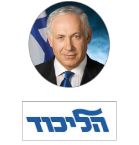Israel: Major Issues and U.S. Relations
Changes from March 9, 2020 to May 18, 2020
This page shows textual changes in the document between the two versions indicated in the dates above. Textual matter removed in the later version is indicated with red strikethrough and textual matter added in the later version is indicated with blue.
Contents
- Introduction: Major Issues for U.S.-Israel Relations
- Domestic Issues:
Will Netanyahu Remain Prime Minister?Unity Government, Possible West Bank Annexation, and COVID-19
- Israeli-Palestinian Issues Under the Trump Administration
- Key Points of the U.S. Plan
- Possible Israeli West Bank Annexation
- Regional and International
Reactions to the U.S. PlanViews
- Gaza and Its Challenges
- How Israel Addresses Threats
- Military Superiority and Homeland Security Measures
U.S.U.S. Security Cooperation- Iran and the Region
- Iranian Nuclear Issue and Regional Tensions
- Syria, Iraq, and Lebanon
- Hezbollah
- Syria and Iraq: Reported Israeli Airstrikes Against Iran-Backed Forces
Figures
Summary
The following matters are of particular significance to U.S.-Israel relations.
Domestic issues. Will Netanyahu remain prime minister? On March 2, 2020, Israel held its third election in the past year—a development unprecedented in the country's history. Israeli Prime Minister Binyamin Netanyahu's Likud party won the most votes, despite criminal indictments against Netanyahu for corruption. However, the bloc of parties that are his traditional coalition allies fell three votes short of a Knesset majority. Netanyahu's main political rival Benny Gantz, of the Kahol Lavan party, may have enough support from parties opposing Netanyahu to have the first chance to form a government. This support could lead to a bill preventing Netanyahu from forming a government—due to the indictments he faces—though the legislation might not take effect until another election takes place. Ending Israel's political stalemate could depend on whether Avigdor Lieberman of the right-of-center, pro-secular Yisrael Beitenu party is willing to join a Gantz-led government that receives outside support from the Arab-led Joint List.
If Netanyahu forms the next government, he may pursue initiatives that could reduce the independence of Israel's judiciary and lead to West Bank annexation. It is unclear how a Likud-Kahol Lavan unity government or a government without Netanyahu might approach these issues. It is also unclear whether, under Israeli law, Netanyahu could annex West Bank territory while acting in a caretaker capacity.
Israeli-Palestinian issues and the Trump peace planIsraeli unity government, possible West Bank annexation, and COVID-19. In May 2020, Israeli Prime Minister Binyamin Netanyahu and his main political rival Benny Gantz formed a unity government, bringing an end to a long political stalemate in Israel that had continued through three elections in April 2019, September 2019, and March 2020. Netanyahu and Gantz cited the COVID-19 pandemic and the need to address its public health, economic, and other implications for Israel as a major reason for their agreement. By accepting a unity government, Gantz departed from his campaign pledge not to join with Netanyahu, who is scheduled to begin a criminal trial on corruption charges on May 24. While the agreement provides for Gantz to rotate into the position of prime minister by November 2021, and appears to give him broad powers of approval over the government's actions, his choice to join Netanyahu split his Kahol Lavan party and might leave Netanyahu with an overall political advantage.
Arguably, the most significant aspect of the Netanyahu-Gantz deal for U.S. policy is its explicit authorization of a cabinet and Knesset vote on annexing West Bank territory—in coordination with the United States—after July 1, 2020 (see more on the issue's significance below). U.S. officials have said that any U.S. approval for Israeli annexation of West Bank areas would come after a U.S.-Israel committee (established under the Trump Administration peace plan discussed below) can pinpoint areas earmarked for eventual Israeli sovereignty.
Israeli-Palestinian issues: The Trump plan and possible annexation. President Trump has expressed interest in helping resolve the decades-old Israeli-Palestinian conflict. His policies, however, have largely sided with Israeli positions, thus alienating Palestine Liberation Organization (PLO) Chairman and Palestinian Authority (PA) President Mahmoud Abbas. On January 28, 2020, the President released a long-promised peace plan for Israel and the Palestinians. The plan appears to favor Israeli positions on core issues of dispute such as borders and settlements, the status of Jerusalem and its holy sites, security, and Palestinian refugees. The Palestinians would face significant domestic difficulties in taking the steps that the plan proposes for them to qualify for statehood.
Prospects for negotiations based on the U.S. plan appear relatively dim given strong Palestinian opposition and Netanyahu's announced intention to annex parts of the West Bank. U.S. officials have said that any U.S. approval for Israeli annexation of West Bank areas would come after a U.S.-Israel committee can pinpoint areas earmarked for eventual Israeli sovereignty. West Bank annexation could provoke international opposition and affect regional stability, including in neighboring Jordan. Arab states could influence developments on Israeli-Palestinian issues, although their positions have varied by country and over time.
Israeli clashes with Palestinian militants in the Gaza Strip periodically escalate, but Israel and the Sunni Islamist group Hamas (a U.S.-designated terrorist organization) have continued indirect talks toward a long-term cease-fire.
Some say the possible West Bank annexation that the U.S. plan appears to accept under certain conditions could provoke international opposition, worsen Israeli-Palestinian tensions, and affect relations with neighboring Jordan. Annexation may be contrary to international law and some Members of Congress oppose it. Responses by Congress or other U.S. actors could depend on various factors, including how closely any annexation might be coordinated with the Administration, and responses from Palestinians, Arab states, and other international actors.Israel's ability to address threats. Israel relies on a number of strengths—including regional military superiority—to manage potential threats to its security, including evolving asymmetric threatsprescribes for them to qualify for statehood.
Iran and other regional issues. Israeli officials seek to counter Iranian regional influence and prevent Iran from acquiring nuclear weapons. Prime Minister Netanyahu strongly supported President Trump's withdrawal of the United States from the 2015 international agreement that constrained Iran's nuclear activities. Facing intensified U.S. sanctions, Iran has reduced its compliance with the 2015 agreement. U.S.-Iran tensions have led to greater regional uncertainty, with implications for Israel. Israel has reportedly conducted a number of military operations in Syria, Iraq, and Lebanon against Iran and its allies due to concerns about Iran's efforts to establish a permanent presence in these areas and to improve the accuracy and effectiveness of Lebanese Hezbollah's missile arsenal.
Introduction: Major Issues for U.S.-Israel Relations
Israel (see Appendix A) has forged close bilateral cooperation with the United States in many areas; issues with significant implications include the following.
- Israeli domestic political issues, especially questions surrounding
Prime Minister Binyamin Netanyahu's prospects of continuing as prime minister following Israel's March 2 election, the third in the past yearthe new unity government forged by Prime Minister Binyamin Netanyahu and Benny Gantz during the COVID-19 pandemic. - Israeli-Palestinian issues and U.S. policy, including the Trump Administration's peace plan released in January 2020 and issues surrounding possible Israeli West Bank annexation.
- Israel's
own capabilities for addressing external threats, and itssecurity cooperation with the United States. - Shared U.S.-Israel concerns about Iran's nuclear program and regional influence, including with
Iran's Lebanon-based ally Hezbollah. In the past year, Israel has reportedly engaged in airstrikes against Iranian or Iran-allied targets in Syria and Iraq as well as LebanonLebanon-based Hezbollah, Syria, and Iraq.
For background information and analysis on these and other topics, including aid, arms sales, and missile defense cooperation, see CRS Report RL33476, Israel: Background and U.S. Relations, by Jim Zanotti; and CRS Report RL33222, U.S. Foreign Aid to Israel, by Jeremy M. Sharp.
|
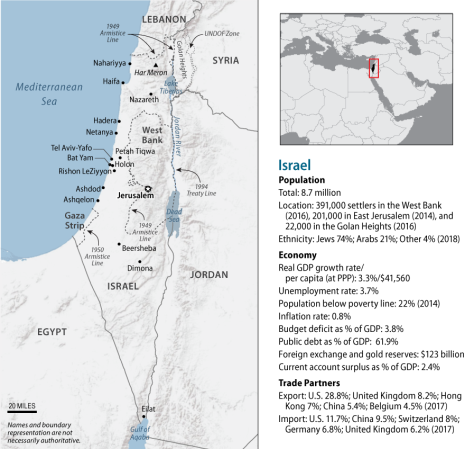 |
Sources: Graphic created by CRS. Map boundaries and information generated by Hannah Fischer using Department of State Boundaries (2011); Esri (2013); the National Geospatial-Intelligence Agency GeoNames Database (2015); DeLorme (2014). Fact information from CIA, The World Factbook; Economist Intelligence Unit; IMF World Economic Outlook Database. All numbers are estimates as of 2019 unless specified.
|
Domestic Issues: Will Netanyahu Remain Prime Minister?
On March 2, 2020, Israel held its third election in the past year because neither of the previous two elections (in April and September 2019) resulted in the formation of a new government. Before this political stalemate, no Israeli election had failed to garner Knesset majority support for a new government. According to unofficial results, the Likud party, led by Prime Minister Netanyahu, won the most Knesset seats in the March 2 election (see Appendix A), despite criminal indictments against Netanyahu for corruption (see Appendix B). However, the bloc of right-of-center and ultra-Orthodox parties that are Netanyahu's traditional political allies are three seats short of a majority, partly due to a strong showing by the Arab-led Joint List, which was reportedly fueled by high turnout from Israel's Arab citizens and some Jewish votes.1 Netanyahu's criminal trial is scheduled to begin on March 17, though he has requested a 45-day postponement.2
The person who will be assigned in mid-March by Israeli President Reuven Rivlin to form a government will have an initial four weeks to build a coalition, followed by a possible two-week extension, and possibly opportunities for someone else if the first person is unsuccessful.3 If no one can garner majority support for a new government, another election would presumably take place later in 2020. Netanyahu—or, if he leaves office, a successor—will serve as prime minister in a caretaker or interim capacity until someone establishes a majority-backed coalition.4
Despite Likud's three-seat electoral advantage over Benny Gantz and his Kahol Lavan party (see Appendix A), Gantz may have enough support from the other parties that oppose Netanyahu (Joint List, Labor-Gesher-Meretz, and Yisrael Beitenu) to receive President Rivlin's first mandate to form a government.5 If that happens, a Knesset majority could pass a bill that would prevent Netanyahu—due to the indictments he faces—from forming a government. It is unclear whether the bill, if enacted, would affect this government formation process or only apply if another election takes place.6 Reports have surfaced that Avigdor Lieberman of Yisrael Beitenu—a right-of-center, pro-secular party—may support the proposed bill and recommend that Gantz form the next government.7 However, Lieberman has been unwilling to date to join either a Gantz-led government supported by the Arab-led Joint List, or a Netanyahu-led government with ultra-Orthodox parties.8 Unless that changes, Israel's yearlong political stalemate may continue, with a number of possibilities if the parties go to a fourth election.9
Possible outcomes leading to a majority-backed coalition from the March election include:
- Unity government if Gantz and Netanyahu agree to govern together.
- Minority government if Gantz is willing and able to govern with other parties opposed to Netanyahu, and with the outside support of the Joint List.10
- Right-of-center majority if Netanyahu can get at least three Knesset members from other parties to join with his traditional coalition allies.11
If Netanyahu forms the next government, he may pursue initiatives that could reduce the independence of Israel's judiciary and lead to West Bank annexation.12 It is unclear how a unity government or a government without Netanyahu might approach these issues, and whether Netanyahu could annex West Bank territory under Israeli law while acting in a caretaker capacity.13 Netanyahu has promised to annex significant territory in the West Bank in conjunction with the Israeli-Palestinian peace plan released by President Trump on January 28, 2020.14
Israeli-Palestinian Issues Under the Trump Administration15
Domestic Issues: Unity Government, Possible West Bank Annexation, and COVID-19
On May 17, 2020, Prime Minister Netanyahu of the Likud party and his main political rival Benny Gantz of the Kahol Lavan (Blue and White) party formed a unity government with majority backing from the Israeli Knesset that was elected on March 2 (see Appendix B). Under the unity agreement, Netanyahu is expected to serve as prime minister and Gantz as alternate prime minister and defense minister for the first 18 months of that time, at which point Gantz is set to become prime minister for the next 18 months, with Netanyahu as his alternate.1
Two previous elections—in April and September 2019—did not produce a government backed by a Knesset majority, and the Netanyahu-Gantz agreement prevented Israel from going to an election later this year that would have been the fourth in two years. Netanyahu and Gantz cited the COVID-19 pandemic and the need to address its public health, economic, and other implications for Israel as a major reason for forming a unity government and averting a fourth election.
COVID-19: Implications for Israel
Relative to many developed countries, the COVID-19 pandemic has not led to a systemic public health crisis to date in Israel. Measures that significantly constrained economic activity in March and April 2020 are gradually being phased out. The Netanyahu-Gantz unity deal envisions that the government will focus largely on issues related to COVID-19 for its first few months. According to projections, Israel's generally vibrant and diversified economy could experience continuing hardship into 2021 or beyond (see Appendix A), with a number of possible factors influencing the intensity and duration of the downturn.2 Israel has been coordinating on COVID-19 measures with Palestinian officials in both the West Bank and Gaza. Gantz's decision in March to accept the principle of a unity government departed from his campaign pledge not to join with Netanyahu because of the criminal indictments against him for corruption (see Appendix C). At the time of this decision, Gantz had previously received Knesset majority support to lead government formation efforts and consider legislation to prevent Netanyahu from serving as prime minister. However, two members of his own party (Kahol Lavan) stalemated those government formation efforts by refusing to serve in a coalition supported by the Arab-led Joint List. When Gantz decided to pursue a unity government, Kahol Lavan split, with other key members Yair Lapid and Moshe Ya'alon denouncing Gantz's decision and leading their Yesh Atid-Telem party into the opposition.Key Aspects of Unity Government
Observers analyzing the Netanyahu-Gantz deal have identified various perceived benefits to the unity agreement for both sides.3 Potential benefits for Netanyahu include his continuation as prime minister and apparent ability to remain in government until he exhausts all appeals (if convicted), his ability to hold votes on West Bank annexation, an effective veto over appointments of key judiciary and justice sector officials, and holding sway with the Knesset's right-of-center majority even during Gantz's time as prime minister. Potential benefits for Gantz include Netanyahu's lack of immunity from criminal proceedings, safeguards intended to ensure that Gantz will become prime minister 18 months through the government's term (as agreed), co-ownership of the governing and legislative agenda, and effective control over half the cabinet and positions (including the defense, foreign, and justice ministries) with significant influence on national security and rule of law in Israel. Despite the details of this political agreement, it is unclear whether either party would be able to compel its legal enforcement, as in the case if Netanyahu were to refuse to step down as prime minister.4New elections would take place in the event that the government is dissolved. Although under the terms of the unity agreement, Gantz would serve as caretaker prime minister before such elections if Netanyahu is responsible for the dissolution, some commentators assert that Netanyahu could hold an advantage—and perhaps even gain a mandate to pass legislation reinstating himself—given various factors, including his enduring political appeal and Kahol Lavan's March 2020 split.5
Some of the elements of the unity agreement that have been codified in Israeli law remain subject to legal challenge in Israel's Supreme Court.6 Some critics have voiced concern that certain provisions crafted to accommodate the political exigencies of the Netanyahu-Gantz deal by diminishing the Knesset's role could undermine democracy in Israel.7
Arguably, the most significant aspect of the Netanyahu-Gantz deal for U.S. policy is that it explicitly allows the cabinet and Knesset to vote on annexing West Bank territory—in coordination with the United States—after July 1, 2020. Pursuant to the Trump Administration's January 2020 peace plan, a U.S.-Israel joint committee has been meeting to finalize the geographical contours of West Bank areas—including Jewish settlements and much of the Jordan Valley8—that the U.S. plan anticipates would be part of Israel. U.S. officials have stated support for Israel annexing these areas after the committee generates these detailed maps. The Palestinians, Arab states, many other international actors, and some Members of Congress oppose Israeli annexation of West Bank areas because of concerns that it could contravene international law and existing Israeli-Palestinian agreements, and negatively affect regional cooperation. It is unclear whether this opposition will affect Israeli or Trump Administration actions. For more detailed information, see "Possible Israeli West Bank Annexation" and "Regional and International Views" below. The issue of annexation has become increasingly prominent in Israeli domestic politics. In each of Israel's three recent electoral campaigns (April 2019, September 2019, March 2020), Netanyahu said he would move forward with annexation if he could form a government. Some observers assert that Netanyahu's rhetorical support for annexation helps him maintain support among right-of-center constituencies for political survival amid his legal difficulties, and thus question how much he will actually pursue annexation.9 Gantz, in connection with the release of the U.S. plan in January 2020, stated his support for annexation to the extent that it could be coordinated with the international community. The Netanyahu-Gantz deal calls for Israel to engage in dialogue with international actors on the annexation issue "with the aim of preserving security and strategic interests including regional security, preserving existing peace agreements and working towards future peace agreements."10 However, the unity agreement does not permit Gantz to block efforts by Netanyahu to bring the issue to a vote. During his unity negotiations with Netanyahu, Gantz reportedly expressed a preference for a limited plan of annexation that would apply Israeli law to areas with a high concentration of settlers.11 Israeli-Palestinian Issues Under the Trump Administration12President Trump has expressed interest in helping resolve the decades-old Israeli-Palestinian conflict. However, his policies have largely favored Israeli positions, thus alienating Palestine Liberation Organization (PLO) Chairman and Palestinian Authority (PA) President Mahmoud Abbas.
Selected U.S. Actions Impacting Israeli-Palestinian Issues
|
December 2017 |
President Trump recognizes Jerusalem as Israel's capital, prompting the PLO/PA to cut off high-level diplomatic relations with the United States |
|
May 2018 |
U.S. embassy opens in Jerusalem |
|
August 2018 |
Administration ends contributions to U.N. Relief and Works Agency for Palestine Refugees in the Near East (UNRWA) |
|
September 2018 |
Administration reprograms FY2017 economic aid for the West Bank and Gaza to other locations; announces closure of PLO office in Washington, DC |
|
January 2019 |
As a result of the Anti-Terrorism Clarification Act of 2018 (P.L. 115-253), the Administration ends all bilateral U.S. aid to the Palestinians |
|
March 2019 |
The U.S. consulate general in Jerusalem—previously an independent diplomatic mission to the Palestinians—is subsumed under the authority of the U.S. embassy to Israel; President Trump recognizes Israeli sovereignty in the Golan Heights |
|
June 2019 |
At a meeting in Bahrain, U.S. officials roll out $50 billion economic framework for Palestinians in the region tied to the forthcoming peace plan; PLO/PA officials reject the idea of economic incentives influencing their positions on core political demands |
|
November 2019 |
Secretary of State Michael Pompeo says that the Administration disagrees with a 1978 State Department legal opinion stating that Israeli West Bank settlements are inconsistent with international law |
|
January 2020 |
President Trump releases peace plan |
On January 28, President Trump released a long-promised "Peace to Prosperity" plan for Israel and the Palestinians,1613 after obtaining expressions of support from both Netanyahu and Gantz. Prospects for holding negotiations seem dim given concerted opposition from Abbas and other Palestinian leaders, and Netanyahu's announced intention to annex parts of the West Bank. Members of Congress have had mixed reactions to the plan.17
Key Points of the U.S. Plan
The plan suggests the following key outcomes as the basis for future Israeli-Palestinian negotiations:18
|
Settlement-Related Announcements After the Plan's Release In February, Netanyahu and his government announced intentions to move forward with plans or construction for Jewish settlements in areas of East Jerusalem (where some refer to settlements as neighborhoods) and the West Bank—including an area known as E-1—that could significantly obstruct territorial contiguity between Palestinian population centers.19 |
- 15Borders and settlements. Israel would acquire sovereignty over about 30% of the West Bank (see Figure
CD-1), including settlements and most of the Jordan Valley.2016 The Palestinians could eventually acquire a limited form of sovereignty (as described below) over the remaining territory. This includes areas that the Palestinian Authority (PA) currently administers, along with some territory currently belonging to Israel (with few Jewish residents) that the Palestinians would acquire via swaps to partially compensate for West Bank territory taken by Israel. Some areas with minimal contiguity would be connected by roads, bridges, and tunnels (see FigureCD-2). Neither Israeli settlers nor Palestinian West Bank residents would be forced to move. The plan anticipates that an agreement could transfer some largely Israeli Arab communities—including an area called the "Arab Triangle"—to a future Palestinian state. In the days after the plan's release, hundreds of residents of the Triangle communities protested the possibility that their citizenship could change, prompting senior Israeli officials to statethatthe Triangle communities would not be involved in any border revision.2117
- Jerusalem and its holy sites. Israel would have sovereignty over nearly all of Jerusalem, with the Palestinians able to obtain some small East Jerusalem areas on the other side of an Israeli separation barrier.
2219 Taken together, the plan and its accompanying White House fact sheet say that the "status quo" on the Temple Mount/Haram al Sharif—which prohibits non-Muslim worship there—would continue, along with Jordan's custodial role regarding Muslim holy sites.2320 However, the plan also says, "People of every faith should be permitted to pray on the Temple Mount/Haram al-Sharif, in a manner that is fully respectful to their religion, taking into account the times of each religion's prayers and holidays, as well as other religious factors." A day after the plan's release, U.S. Ambassador to Israel David Friedman clarified that the status quo would not change absent the agreement of all parties, while adding that the Administration hoped that an eventual accord would allow Jews to pray on the Temple Mount as part of greater openness "to religious observance everywhere."2421
- Security. Israel would retain overall security control over the entire West Bank permanently, though Palestinians would potentially assume more security responsibility, over time, in territory they administer.
2522 - Palestinian refugees. Palestinian refugee claims would be satisfied through internationally funded compensation and resettlement outside of Israel (i.e., no "right of return" to Israel) in the West Bank, Gaza, and third-party states.
- Palestinian statehood. The Palestinians could obtain a demilitarized state within the areas specified in Figure
CD-2 and Figure C-3, with a capital in Abu Dis or elsewhere straddling the East Jerusalem areas mentioned above and their outskirts.2623 Statehood would depend on the Palestinians meeting specified criteria over the next four years that present considerable domestic and practical challenges.2724 Such criteria include disarming Hamas in Gaza, ending certain international initiatives and financial incentives for violence, and recognizing Israel as "the nation state of the Jewish people."28
|
Settlement-Related Announcements After the Plan's Release In February, Netanyahu and his caretaker government announced intentions to move forward with plans or construction for Jewish settlements in areas of East Jerusalem (where some refer to settlements as neighborhoods) and the West Bank—including an area known as E-1—that could significantly obstruct territorial contiguity between Palestinian population centers.18 |
25Possible Israeli West Bank Annexation
Shortly afterAfter the release of the U.S. plan, Prime Minister Netanyahu announced an intention to havestatements from Trump Administration officials influenced Prime Minister Netanyahu's timetable for having the Israeli government annex West Bank settlements and the Jordan Valley.29 His Netanyahu's initial proposal to act immediately—supported by some comments from U.S. ambassador to Israel David Friedman3026—changed in light of January 30 remarks by White House Senior Adviser Jared Kushner. Kushner said that technical discussions involving a U.S.-Israel committee to pinpoint areas earmarked for eventual Israeli sovereignty (see Figure CD-1) could begin immediately, but that finalizing them would take "a couple of months." Kushner also said that an Israeli government would need to be in place "in order to move forward" with annexation.31
In the wake of Kushner's statements, Netanyahu claimed that he would only seek government approval for annexation after the March 2 election.32 Some observers have speculated that Kushner wants to give the plan an opportunity to garner international support before annexation takes place.33 The U.S.-Israel mapping committee began meeting in February.34 On March 5, one source reported that Kushner told Members of Congress that the United States would be ready to support Israeli annexation within a matter of months if the Palestinians are unwilling to negotiate with Israel on the basis of the U.S. plan.35
Annexation could affect the prospects of reaching a negotiated two-state solution, based on either the U.S. plan or other starting points. Two former U.S. officials have written that "if Israeli annexation is front-loaded and proceeds in the coming months, any Palestinian counter-offer would be pre-empted."3627 The U.S.-Israel mapping committee began meeting in February.28 On March 5, one source reported that Kushner told Members of Congress that the United States would be ready to support Israeli annexation within a matter of months if the Palestinians are unwilling to negotiate with Israel on the basis of the U.S. plan.29
As discussed above, the Israeli government formed in May 2020 has the authority to bring annexation to a vote starting in July. After the government's swearing-in on May 17, Netanyahu stated his intent to bring the issue quickly to a cabinet vote.30 Whether and how a vote takes place may depend on various considerations, including the progress of the U.S.-Israel mapping committee and challenges in achieving consensus among Israeli officials and other key stakeholders.31 A senior State Department official has been cited as saying that the government could "take a while" to reach consensus on annexation in view of various factors, including concerns among Arab states.32 In early May, Ambassador Friedman indicated that the United States is prepared to recognize Israel's application of sovereignty over areas identified by the mapping committee if Israel agrees not to expand settlements beyond those areas, and remains willing to negotiate with Palestinians for their statehood on the basis of the U.S. plan.33 During a May 13 visit to Israel, Secretary of State Michael Pompeo said that Israel has the "right and the obligation" to decide whether and how to proceed with annexation, while also saying that he discussed with Netanyahu and Gantz how to "bring about an outcome in accordance with the [U.S.] vision of peace" and that they would need to "find a way together to proceed."34
Annexation could potentially worsen Israeli-Palestinian tensions and the prospects of reaching a negotiated two-state solution. On May 13, PLO Chairman and PA President Abbas said that the Palestinians would reconsider their position and be absolved of all agreements and understandings with Israel and the United States if Israel declares the annexation of "any part of our occupied lands."35 According to three former senior Israeli security officials, annexation could increase rather than decrease Israel's responsibility for Palestinians in the West Bank and Gaza if it reduces Palestinian willingness to coordinate on security and observe cease-fires.36 Two prominent former U.S. officials have argued that annexation of all settlements and the Jordan Valley would "doom Israel to becoming a binational state that fundamentally alters its identity," while a more limited plan of annexation might not foreclose a two-state solution.37
|
Annexation Under Israeli Law Since Israel's founding in 1948, it has effectively annexed two territories: East Jerusalem and the Golan Heights, both of which Israel captured in the 1967 Arab-Israeli war. Shortly after the war, the Israeli government expanded Jerusalem's municipal boundaries to include all of the previously Jordanian-held East Jerusalem and some surrounding West Bank territory, and proclaimed the municipality to be Israel's capital. The Knesset passed a Basic Law in July 1980 stating that the jurisdiction of Jerusalem runs throughout the expanded municipal boundaries. In December 1981, the Knesset passed a law stating that the "Law, jurisdiction and administration of the state [of Israel] shall apply to the Golan Heights." According to one Israeli legal scholar, under domestic law Israel can apply its law to new territory via governmental decree (if the territory was previously part of the British Mandate of Palestine) or Knesset legislation. According to one article citing various Israeli legal experts, Israel could take a range of approaches to annexation or applying its law to West Bank areas. |
Annexation may be contrary to international law,4344 including various U.N. Security Council resolutions and existing Israeli-Palestinian agreements (the Oslo Accords of the 1990s) that provide for resolving the status of the West Bank and Gaza Strip via negotiations.4445 U.N. Security Council Resolution 2334, adopted in December 2016 with the United States (under the Obama Administration) abstaining, stated that settlements established by Israel in "Palestinian territory occupied since 1967, including East Jerusalem," constitute "a flagrant violation under international law" and a "major obstacle" to a two-state solution and a "just, lasting and comprehensive peace." In December 2019, the House (by a vote of 226-188, with two voting present) passed H.Res. 326, which called for any future U.S. peace proposal to expressly endorse a two-state solution and discouraged steps such as "unilateral annexation of territory or efforts to achieve Palestinian statehood status" outside negotiations.
Regional and International Reactions to the U.S. Plan
The U.S. plan has elicited various regional and international reactions. While some key actors have voiced hope that the plan's release can lead to the resumption of Israeli-Palestinian talks, others have expressed caution or criticism about the plan.
After a meeting of the foreign ministers of the League of Arab States on February 1, the Arab League issued a communique saying that it would not cooperate with the United States to implement the plan and that Israel should not forcibly carry it out.45 It stated its view that the Arab Peace Initiative of 2002 remains the proper basis for a negotiated Israeli-Palestinian peace.46 In the days before the Arab League meeting, Saudi Arabia, Egypt, and the United Arab Emirates expressed qualified openness to supporting a negotiating process based on the plan.47 Some observers surmise that some key Arab states' shared interests with Israel on Iran and other matters may lead them to be less insistent than in the past on Israel meeting Palestinian demands.48
The U.S. plan and the possibility of Israeli West Bank annexation have elicited various regional and international reactions. While some key actors have voiced hope that the plan's release would lead to the resumption of Israeli-Palestinian talks, others have expressed caution or criticism about the plan and its possible implications.
The impact of the plan or possible Israeli annexation on neighboring Jordan is an important issue.4947 Israeli security officials regard Jordan, with which Israel has a peace treaty, as a key regional buffer for Israel. Jordan also hosts key U.S. military assets. While Jordan's monarchy maintains discreet security cooperation with Israel, much of its population—a majority of which is of Palestinian origin—holds negative views about Israel-Jordan relations,5048 which have become strained over the past year.5149 Additionally, Palestinians might look to Jordan to take greater responsibility for them if their own national aspirations remain unfulfilled.52 50
Jordanian officials have expressed concerns about the plan and possible annexation. After the plan's release, Jordanian Foreign Minister Ayman Safadi warned against the "dangerous consequences of unilateral Israeli measures, such as the annexation of Palestinian lands, the building and expansion of illegal Israeli settlements on occupied Palestinian lands and encroachments on the Holy Sites in Jerusalem, that aim at imposing new realities on the ground."53
Other international reactions have encouraged the idea of resuming Israeli-Palestinian negotiations, but raised concerns about parts of the U.S. plan or possible Israeli annexation. For example, Josep Borrell, the European Union High Representative for Foreign Affairs, said on February 4 that the plan departs from internationally agreed parameters for a two-state solution and that Israeli annexation steps "could not pass unchallenged."54 Additionally, annexation could come under investigation by the International Criminal Court (ICC),55 given that the ICC prosecutor has announced her intention to investigate possible war crimes in the West Bank and Gaza if a pre-trial chamber decides that the ICC has jurisdiction there.56
Gaza and Its Challenges
The Gaza Strip—controlled by the Sunni Islamist group Hamas (a U.S.-designated terrorist organization)—faces difficult and complicated political, economic, and humanitarian conditions.57 Palestinian militants in Gaza regularly clash with Israel's military as it patrols Gaza's frontiers with Israel, and the clashes periodically escalate toward larger conflict. Hamas and Israel are reportedly working through Egypt and Qatar in efforts to establish a long-term cease-fire around Gaza that could ease Israel-Egypt access restrictions for people and goods.
How Israel Addresses Threats
Israel relies on a number of strengths to manage potential threats to its security and existence. These strengths include robust military and homeland security capabilities, as well as close cooperation with the United States.
Military Superiority and Homeland Security Measures
Israel maintains military superiority relative to neighboring states and the Palestinians. Shifts in regional order and evolving asymmetric threats have led Israel to update its efforts to project military strength, deter attack, and defend its population and borders. Israel appears to have reduced some unconventional threats via missile defense systems, reported cyber defense and warfare capabilities, and other heightened security measures.
Israel has a robust homeland security system featuring sophisticated early warning practices and thorough border and airport security controls; most of the country's buildings have reinforced rooms or shelters engineered to withstand explosions. Israel also has partially constructed a national border fence network of steel barricades (accompanied at various points by watchtowers, patrol roads, intelligence centers, and military brigades) designed to minimize militant infiltration, illegal immigration, and smuggling from Egypt, Syria, Lebanon, Jordan, and the Gaza Strip.58 Additionally, Israeli authorities have built a separation barrier in and around parts of the West Bank.59
U.S. Cooperation
Other international reactions have encouraged the idea of resuming Israeli-Palestinian negotiations, but raised concerns about parts of the U.S. plan or possible Israeli annexation.59 Senior European Union (EU) and United Nations officials have warned Israel that annexation by its new government would violate international law,60 and reports suggest that the EU or its member states may consider reducing some forms of economic cooperation with Israel in response to annexation.61 Additionally, annexation could come under investigation by the International Criminal Court (ICC),62 given that the ICC prosecutor has announced her intention to investigate possible war crimes in the West Bank and Gaza if a pre-trial chamber decides that the ICC has jurisdiction there.63 The Gaza Strip—controlled by the Sunni Islamist group Hamas (a U.S.-designated terrorist organization)—faces difficult and complicated political, economic, and humanitarian conditions.64 Palestinian militants in Gaza regularly clash with Israel's military as it patrols Gaza's frontiers with Israel, and the clashes periodically escalate toward larger conflict. Hamas and Israel are reportedly working through Egypt and Qatar in efforts to establish a long-term cease-fire around Gaza that could ease Israel-Egypt access restrictions for people and goods.Israeli officials closely consult with U.S. counterparts in an effort to influence U.S. decision-making on key regional issues, and U.S. law requires the executive branch to take certain actions to preserve Israel's "qualitative military edge," or QME.6051 Following the announcement of the Israeli unity government in April, Foreign Minister Safadi reportedly asked several foreign governments to discourage Israel from annexing the Jordan Valley and other parts of the West Bank.52 Then, in a May interview, King Abdullah II said, "If Israel really annexed the West Bank in July, it would lead to a massive conflict with the Hashemite Kingdom of Jordan." When asked if he would suspend Jordan's peace treaty with Israel, the King said, "I don't want to make threats and create an atmosphere of loggerheads, but we are considering all options."53
Arab states' positions could influence U.S. and Israeli actions.54 Some observers have surmised that some key Arab states' shared interests with Israel on Iran and other matters may lead them to be less insistent than in the past on Israel meeting Palestinian demands.55 After a meeting of the foreign ministers of the League of Arab States on February 1, the Arab League issued a communique saying that it would not cooperate with the United States to implement the U.S. plan and that Israel should not forcibly carry it out.56 It stated its view that the Arab Peace Initiative of 2002 remains the proper basis for a negotiated Israeli-Palestinian peace.57 After a virtual meeting of Arab League foreign ministers on April 30, the ministers issued a joint statement saying that annexation of any part of the lands occupied in 1967 would be a "new war crime" against the Palestinians and urged the United States to withdraw its support from enabling Israel's plans.58
6166 though some discussions about the possibility of a treaty have apparently taken place since September 2019.62
Iran and the Region
Israeli officials cite Iran as a primary concern to Israeli officials, largely because of (1) antipathy toward Israel expressed by Iran's revolutionary regime, (2) Iran's broad regional influence (especially in Syria, Iraq, and Lebanon),6368 and (3) Iran's nuclear and missile programs and advanced conventional weapons capabilities. Israel and Arab Gulf states have cultivated closer relations with one another in efforts to counter Iran.
Iranian Nuclear Issue and Regional Tensions
Prime Minister Netanyahu has sought to influence U.S. decisions on the international agreement on Iran's nuclear program (known as the Joint Comprehensive Plan of Action, or JCPOA). He opposed the JCPOA when it was negotiated by the Obama Administration, and welcomed President Trump's May 2018 withdrawal of the United States from the JCPOA and accompanying reimposition of U.S. sanctions on Iran's core economic sectors. Facing the intensified U.S. sanctions, Iran has reduced its compliance with the 2015 agreement.
U.S.-Iran tensions since the U.S. withdrawal from the JCPOA have led to greater regional uncertainty, with implications for Israel.6469 Some Israelis have voiced worries about how Iran's apparent ability to penetrate Saudi air defenses and target Saudi oil facilities could transfer to efforts in targeting Israel.6570
Syria, Iraq, and Lebanon
Hezbollah
Lebanese Hezbollah is Iran's closest and most powerful non-state ally in the region. Hezbollah's forces and Israel's military have sporadically clashed near the Lebanese border for decades—with the antagonism at times contained in the border area, and at times escalating into broader conflict.6671 Speculation persists about the potential for wider conflict and its regional implications.6772 Israeli officials have sought to draw attention to Hezbollah's buildup of mostly Iran-supplied weapons—including reported upgrades to the range, precision, and power of its projectiles—and its alleged use of Lebanese civilian areas as strongholds.6873
Ongoing tension between Israel and Iran raises questions about the potential for Israel-Hezbollah conflict. Various sources have referenced possible Iran-backed Hezbollah initiatives to build precision-weapons factories in Lebanon.6974 In late 2018 and early 2019, Israel's military undertook an effort—dubbed "Operation Northern Shield"—to seal six Hezbollah attack tunnels to prevent them from crossing into Israel.7075 In August 2019, Israel may have conducted airstrikes targeting Hezbollah personnel and advanced drone and missile technology in Syria and Lebanon.7176 Hezbollah appeared to respond to Israel in early September with cross-border fire from Lebanon targeting an Israeli military unit,7277 amid reports that Hezbollah sought to retaliate but avoid escalation toward war.73
Syria and Iraq: Reported Israeli Airstrikes Against Iran-Backed Forces
Israel has reportedly undertaken airstrikes in conflict-plagued Syria and Iraq based on concerns that Iran and its allies could pose threats to Israeli security from there. Iran's westward expansion of influence into Iraq and Syria over the past two decades has provided it with more ways to supply and support Hezbollah, apparently leading Israel to increasingly broaden its regional theater of military action.7480 The U.S. base at At Tanf in southern Syria reportedly serves as an impediment to Iranian efforts to create a land route for weapons from Iran to Lebanon.7581 Russia, its airspace deconfliction mechanism with Israel, and some advanced air defense systems that it has deployed or transferred to Syria also influence the various actors involved.76
Since 2018, Israeli and Iranian forces have repeatedly targeted one another in Syria or around the Syria-Israel border. After Iran helped Syria's government regain control of much of the country, Israeli leaders began pledging to prevent Iran from constructing and operating bases or advanced weapons manufacturing facilities in Syria.77
In Iraq, reports suggest that in the summer of 2019, Israel conducted airstrikes against weapons depots or convoys that were connected with Iran-allied Shiite militias. A December 2019 media report citing U.S. officials claimed that Iran had built up a hidden arsenal of short-range ballistic missiles in Iraq that could pose a threat to U.S. regional partners, including Israel.7886 Perhaps owing to sensitivities involving U.S. forces in Iraq, Israeli then-Defense Minister Naftali Bennett suggested in February 2020 that Israel would avoid further direct involvement there—leaving any efforts to counter Iran-backed forces in Iraq to the United States.79
Figure A-1. Israel: Map and Basic Facts
Sources: Graphic created by CRS. Map boundaries and information generated by Hannah Fischer using Department of State Boundaries (2011); Esri (2013); the National Geospatial-Intelligence Agency GeoNames Database (2015); DeLorme (2014). Fact information from CIA, The World Factbook; Economist Intelligence Unit; IMF World Economic Outlook Database. All numbers are estimates as of 2020 unless specified. Numbers for 2021 are projections.
Notes: According to the U.S. executive branch: (1) The West Bank is Israeli occupied with current status subject to the 1995 Israeli-Palestinian Interim Agreement; permanent status to be determined through further negotiation. (2) The status of the Gaza Strip is a final status issue to be resolved through negotiations. (3) The United States recognized Jerusalem as Israel's capital in 2017 without taking a position on the specific boundaries of Israeli sovereignty. (4) Boundary representation is not necessarily authoritative. Additionally, the United States recognized the Golan Heights as part of Israel in 2019; however, U.N. Security Council Resolution 497, adopted on December 17, 1981, held that the area of the Golan Heights controlled by Israel's military is occupied territory belonging to Syria. The current U.S. executive branch map of Israel is available at https://www.cia.gov/library/publications/the-world-factbook/attachments/maps/IS-map.gif. Appendix B.Appendix A.
Israeli Political Parties in the Next Knesset and Their Leaders
|
RIGHT |
|
|
|
Likud (Consolidation) – 36 Knesset seats Leader: Binyamin Netanyahu |
|
|
Yisrael Beitenu (Israel Our Home) – 7 seats Leader: Avigdor Lieberman |
|
|
Yamina (Right) – Leader: Naftali Bennett |
|
LEFT |
|
|
|
Labor Leader: Amir Peretz |
|
Meretz (Vigor) – 3 seats (Opposition) Meretz is a pro-secular Zionist party that supports initiatives for social justice and peace with the Palestinians, and former Prime Minister Ehud Barak's Israel Democratic Party. Leader: Nitzan Horowitz Born in 1965, Horowitz became Meretz's leader in June 2019 and was first elected to the Knesset in 2009. He had a long career as a prominent journalist before entering politics.CENTER |
|
|
|
Kahol Lavan (Blue and White) – Centrist party largely formed as an alternative to Prime Minister Netanyahu, ostensibly seeking to preserve long-standing Israeli institutions such as the judiciary, articulate a vision of Israeli nationalism that is more inclusive of Druze and Arab citizens, and have greater sensitivity to international opinion on Israeli-Palestinian issues. Yesh Atid-Telem – 16 seats (Opposition) Yesh Atid (There Is a Future) is a centrist party in existence since 2012 that has championed socioeconomic issues such as cost of living and has taken a pro-secular stance. Telem (Hebrew acronym for National Statesman-like Movement) formed in January 2019 by former Defense Minister Moshe Ya'alon as a center-right, pro-nationalist alternative to Netanyahu. The parties merged with Hosen L'Yisrael in early 2019, then split from it in March 2020. Derech Eretz (Way of the Land) – 2 seats (Coalition) Center-right faction formed from the split of Kahol Lavan in March 2020. Merger between two centrist parties, Hosen L'Yisrael (Resilience) and Yesh Atid (There Is a Future).
|
|
|
|
|
|
Shas (Sephardic Torah Guardians) – 9 seats Leader: Aryeh Deri |
|
|
United Torah Judaism – 7 seats Leader: Yaakov Litzman |
|
|
|
|
|
Joint List – 15 seats (Opposition)Electoral slate featuring four Arab parties that combine socialist, Islamist, and Arab nationalist political strains: Hadash (Democratic Front for Peace and Equality), Ta'al (Arab Movement for Renewal), Ra'am (United Arab List), Balad (National Democratic Assembly). Leader: Ayman Odeh |
Sources: Various open sources.
Note: Knesset seat numbers based on unofficial results from the March 2, 2020, election.
Appendix B.
Indictments Against Netanyahu and Steps of the Legal Process
|
Indictments |
|
Case 1000: Netanyahu received favors from Hollywood mogul Arnon Milchan and Australian billionaire James Packer, in return for taking actions in Milchan's favor. The charge: Fraud and breach of trust Netanyahu's defense: There is no legal problem in receiving gifts from friends; did not know that his family members requested gifts. |
|
Case 2000: Netanyahu and Yedioth Ahronoth publisher Arnon Mozes struck a deal: Favorable coverage for Netanyahu in return for limiting the circulation of the Sheldon Adelson-owned newspaper Israel Hayom. The charge: Fraud and breach of trust Netanyahu's defense: He had no intention of implementing the deal, and relations between politicians and the media should not be criminalized. |
|
Case 4000: As communication minister, Netanyahu took steps that benefited Shaul Elovitch who controlled telecom company Bezeq—in return for favorable coverage in Bezeq's Walla News site The charge: Bribery, fraud and breach of trust Netanyahu's defense: There is no evidence that he was aware of making regulations contingent on favorable coverage. |
|
Selected Steps in the Legal Process, and |
|
|
Sources: For "Indictments," the content comes from Ha'aretz graphics adapted by CRS. For "Selected Steps in the Legal Process, and the Time Between Them," CRS prepared the graphic and made slight content adjustments to underlying source material from Britain Israel Communications and Research Centre. The interval listed between Steps 4-5 is an estimate.
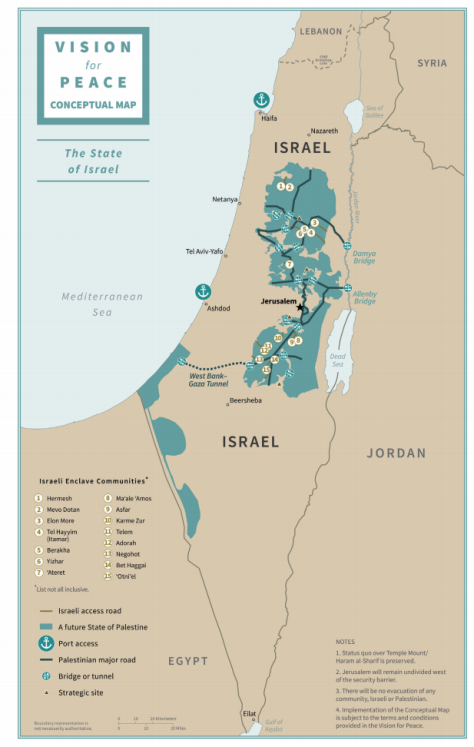 |
|
Source: White House, Peace to Prosperity: A Vision to Improve the Lives of the Palestinian and Israeli People, January 2020. |
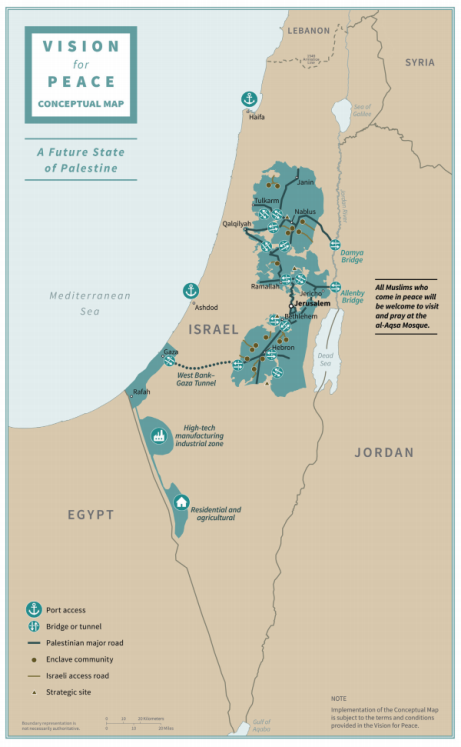 |
|
Source: White House, Peace to Prosperity: A Vision to Improve the Lives of the Palestinian and Israeli People, January 2020. |
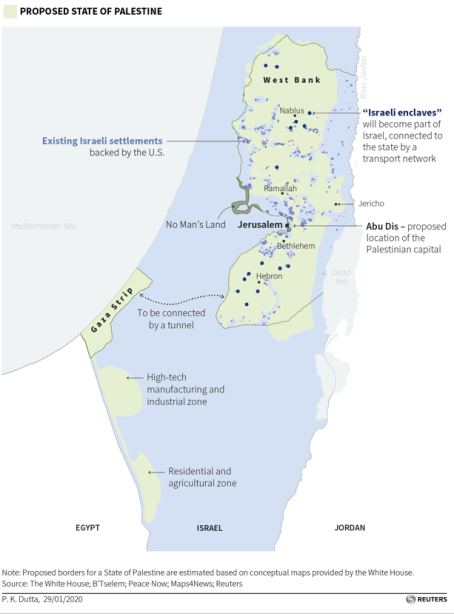 |
|
Notes: Green lines on map represent 1949-1967 Israel-Jordan armistice line (for West Bank) and 1950-1967 Israel-Egypt armistice line (for Gaza). All borders are approximate. |
Author Contact Information
Footnotes
| 1. |
| ||||||||||||||||||||||
| 2. |
"Netanyahu formally requests delay of corruption trial for 45 days," Times of Israel, March 9, 2020. |
||||||||||||||||||||||
| 3. |
Jonathan Lis, "Israel's Election Is Over, So Now What? The Key Dates to Expect," haaretz.com, March 3, 2020. |
||||||||||||||||||||||
| 4. |
According to Section 30(c) of Israel's Basic Law: The Government, if the prime minister's tenure ends, "the Government shall designate another of the Ministers who is a member of the Knesset and of the Prime Minister's faction to be Interim Prime Minister pending the constitution of the new Government." |
||||||||||||||||||||||
| 5. |
Yossi Verter, "Netanyahu's Hat Has Run Out of Rabbits. Now Lieberman Can Finish Him Off," haaretz.com, March 6, 2020. |
||||||||||||||||||||||
| 6. |
Jonathan Lis and Aaron Rabinowitz, "Israel Election: Gantz Meets for Coalition Talks with Lieberman," haaretz.com, March 9, 2020. Separately, Kahol Lavan and other parties could petition Israel's Supreme Court to prevent Netanyahu from having the mandate to form a government. In a January 2020 ruling on the question of whether a person under indictment could be tasked to form a government, the court declined to make a definitive decision, stating that the question was hypothetical before an election. |
||||||||||||||||||||||
| 7. |
Raoul Wootliff, "Liberman may recommend Gantz for PM, will support bill to disqualify Netanyahu," Times of Israel, March 5, 2020. |
||||||||||||||||||||||
| 8. |
Tovah Lazaroff, "Liberman says 'no fourth election,' remains kingmaker by slim margin," jpost.com, March 3, 2020; "Lieberman Rules Out Joining Government with Arab Israeli Parties," haaretz.com, February 14, 2020. |
||||||||||||||||||||||
| 9. |
Haviv Rettig Gur, "Ousting Netanyahu may turn out to be Gantz's biggest mistake," Times of Israel, March 6, 2020. |
||||||||||||||||||||||
| 10. |
In Israel's history, no Arab-led party has joined a government, but there is a precedent for outside Arab support for a coalition led by Prime Minister Yitzhak Rabin in the 1990s. |
||||||||||||||||||||||
| 11. |
Jonathan Lis, "Netanyahu Tries to Lure Lawmakers to Defect in Hunt for 61 Seats," haaretz.com, March 5, 2020. |
||||||||||||||||||||||
| 12. |
Yohanan Plesner, "Third Time's a Charm?" The Israel Democracy Institute, February 10, 2020. |
||||||||||||||||||||||
| 13. |
Elena Chachko, "Can the Netanyahu Government Annex Parts of the West Bank?" Lawfare Blog, January 31, 2020; Judah Ari Gross, "Can an interim cabinet that can't fund daycare annex the West Bank? Probably not," Times of Israel, January 29, 2020. |
||||||||||||||||||||||
| 14. |
Chaim Levinson, "Netanyahu Says Cabinet Will Vote on Settlement Annexation Only After Israel's Election," haaretz.com, February 4, 2020. |
||||||||||||||||||||||
| 15. |
For additional background, see CRS In Focus IF11237, Israel and the Palestinians: Chronology of a Two-State Solution, by Jim Zanotti. |
||||||||||||||||||||||
| 2.
|
|
Economist Intelligence Unit, Country Report: Israel, accessed April 27, 2020. 3.
|
|
See, e.g., David Horovitz, "Gantz tries, likely fails, to lock Netanyahu into eventually handing over power," Times of Israel, April 21, 2020; Yossi Verter, "Netanyahu-Gantz Deal Ensures Accused Premier Will Have the Last Word," haaretz.com, April 21, 2020; Chemi Shalev, "Netanyahu-Gantz Unity Deal: The Good, the Bad, the Ugly and the Ominous," haaretz.com, April 21, 2020. 4.
|
|
Horovitz, op. cit. footnote 3. 5.
|
|
See footnote 3. 6.
|
|
"As Knesset passes coalition bills, group swiftly resubmits High Court petition," Times of Israel, May 7, 2020; Jonathan Lis and Chaim Levinson, "Knesset Amends Basic Laws, Clearing Path for Netanyahu-Gantz Government," haaretz.com, May 7, 2020. 7.
|
|
See, e.g., "'Monstrous' coalition deal neuters Knesset. Should judges intervene? Will they?" Times of Israel, April 23, 2020. 8.
|
|
For background information on settlements and U.S. policy, see CRS Report RL33476, Israel: Background and U.S. Relations, by Jim Zanotti. For information on the Jordan Valley, see Ben Sales, "Netanyahu's push to annex the Jordan Valley, explained," Jewish Telegraphic Agency, September 10, 2019. 9.
|
|
See, e.g., Anshel Pfeffer, "Why Netanyahu Will Never Annex West Bank Settlements and the Jordan Valley," haaretz.com, May 7, 2020. 10.
|
|
Britain Israel Communications and Research Centre, "Netanyahu and Gantz agree to form new government," April 21, 2020. 11.
|
|
Tovah Lazaroff, "Gantz weighing limited West Bank settlement annexation – report," jpost.com, April 5, 2020. 12.
|
|
For additional background, see CRS In Focus IF11237, Israel and the Palestinians: Chronology of a Two-State Solution, by Jim Zanotti. |
White House, Peace to Prosperity: A Vision to Improve the Lives of the Palestinian and Israeli People, January 2020, available at https://www.whitehouse.gov/wp-content/uploads/2020/01/Peace-to-Prosperity-0120.pdf. See also White House fact sheet, President Donald J. Trump's Vision for Peace, Prosperity, and a Brighter Future for Israel and the Palestinian People, January 28, 2020. |
|
Laura Kelly, "Democrats offer mixed reactions to Trump's Mideast peace plan," thehill.com, January 28, 2020; Letter to President Trump from 12 Senators at https://www.vanhollen.senate.gov/imo/media/doc/Van%20Hollen%20Letter%20MidEast%20Peace%20Plan.pdf; Letter to the President from 107 Representatives at https://andylevin.house.gov/sites/andylevin.house.gov/files/020620%20House%20letter%20to%20POTUS%20on%20Israeli-Palestinian%20conflict.pdf. |
|||||||||||||||||||||||
|
See footnote |
|||||||||||||||||||||||
|
|
|||||||||||||||||||||||
|
|
19"Netanyahu says will press ahead with E-1 settlement project in West Bank," Reuters, February 25, 2020; "US gave PM green light for Givat Hamatos construction 1.5 years ago – report," Times of Israel, February 25, 2020. |
For background information on settlements and U.S. policy, see CRS Report RL33476, Israel: Background and U.S. Relations, by Jim Zanotti. For information on the Jordan Valley, see Ben Sales, "Netanyahu's push to annex the Jordan Valley, explained," Jewish Telegraphic Agency, September 10, 2019. |
|||||||||||||||||||||
| 21. |
"Israel rejects Trump's idea of redrawing borders, moving Arab towns to Palestine," Times of Israel, February 2, 2020. |
||||||||||||||||||||||
|
David M. Halbfinger and Isabel Kershner, "Trump's Would-Be Palestinian Capital: Dangerous, Scattered Slums," New York Times, February 1, 2020. For background information on and maps of Jerusalem, see CRS Report RL33476, Israel: Background and U.S. Relations, by Jim Zanotti. The East Jerusalem areas earmarked for the Palestinians were added to the Jerusalem municipality after Israel captured East Jerusalem and the West Bank from Jordan in 1967. |
|||||||||||||||||||||||
|
For more information on the "status quo," see CRS Report RL33476, Israel: Background and U.S. Relations, by Jim Zanotti. |
|||||||||||||||||||||||
|
"US envoy: We won't impose change to status quo to let Jews pray at Temple Mount," Times of Israel, January 29, 2020. Some sources remain concerned about the plan's possible change to the "status quo." See, e.g., Ir Amim, "Ramifications of the US Middle East Plan on the Future of Jerusalem," April 2020. |
|||||||||||||||||||||||
|
For background information on Palestinian self-governance, see CRS In Focus IF10644, The Palestinians: Overview and Key Issues for U.S. Policy, by Jim Zanotti. |
|||||||||||||||||||||||
|
See footnote |
|||||||||||||||||||||||
|
White House, Remarks by President Trump and Prime Minister Netanyahu of the State of Israel in Joint Statements, January 28, 2020. During that time, the plan and President Trump's remarks—taken together—anticipate that Israel would refrain from building or expanding Jewish settlements in West Bank areas earmarked for a future Palestinian state, and from demolishing existing structures in those areas—subject to exceptions for safety and responses to acts of terrorism. |
|||||||||||||||||||||||
|
Israeli insistence on Palestinian recognition of Israel as the nation state of the Jewish people was reportedly introduced into an Israeli-Palestinian negotiating context by Tzipi Livni when she was Israeli foreign minister during the 2007-2008 Annapolis negotiations. "The Pursuit of Middle East Peace: A Status Report," Ambassador Martin Indyk, Washington Institute for Near East Policy, May 8, 2014. Other specified criteria for Palestinian statehood include reforms in governance and rule of law, and anti-incitement in educational curricula. |
|||||||||||||||||||||||
|
|
|||||||||||||||||||||||
|
| |||||||||||||||||||||||
| 31. |
"Kushner on Israeli annexation plans: not now," GZERO Media, January 30, 2020. |
||||||||||||||||||||||
| 32. |
Chaim Levinson, "Netanyahu Says Cabinet Will Vote on Settlement Annexation Only After Israel's Election," haaretz.com, February 4, 2020. |
||||||||||||||||||||||
| 33. |
Ben Caspit, "Netanyahu wants/needs annexation before elections," Al-Monitor, January 31, 2020; Lahav Harkov, "Applying 'Deal of the Century' and annexation put on ice – analysis," jpost.com, January 30, 2020; Noa Landau, "Friedman Pushed Netanyahu to Annex, Then Kushner Stepped In," haaretz.com, January 30, 2020. |
||||||||||||||||||||||
| 34. |
"US mapping team for West Bank annexation said en route to Israel," Times of Israel, February 23, 2020. |
||||||||||||||||||||||
| 35. |
Barak Ravid, "U.S. to approve Israeli annexations within months if Palestinians don't negotiate," Axios, March 5, 2020. |
||||||||||||||||||||||
| 36. |
Dennis Ross and David Makovsky, "The problem with Trump's Middle East peace plan," thehill.com, February 23, 2020. |
||||||||||||||||||||||
| 28.
|
|
"US mapping team for West Bank annexation said en route to Israel," Times of Israel, February 23, 2020. 29.
|
|
Barak Ravid, "U.S. to approve Israeli annexations within months if Palestinians don't negotiate," Axios, March 5, 2020. 30.
|
|
Jacob Magid, "After 508-day crisis, Israel's new government finally sworn in by Knesset," Times of Israel, May 17, 2020. 31.
|
|
See, e.g., Judy Maltz, "Netanyahu Is 'Confident' in His Annexation Plan. Experts Outline His Next Steps," haaretz.com, May 4, 2020; Ben Caspit, "Can anyone stop Netanyahu's annexation plans?" Al-Monitor, April 28, 2020. 32.
|
|
U.S. Department of State website, Briefing with Senior State Department Officials On Secretary Pompeo's Travel to Jerusalem, Israel, May 13, 2020. 33.
|
|
"US ambassador says Washington 'ready to recognize annexation' within weeks," Times of Israel, May 6, 2020. 34.
|
|
Raphael Ahren, "Pompeo: New government has 'right and obligation' to decide if and how to annex," Times of Israel, May 14, 2020. One analyst said that Pompeo's remarks could increase Gantz's leverage over Netanyahu on the annexation issue. David M. Halbfinger and Lara Jakes, "Pompeo Visit Seen as Warning to Israel on Annexation," New York Times, May 14, 2020. 35.
|
|
"President Abbas on Nakba anniversary: Despite decades of suffering, our people will prevail," WAFA, May 14, 2020. 36.
|
|
Ami Ayalon, Tamir Pardo, and Gadi Shamni, "Netanyahu's Annexation Plan Is a Threat to Israel's National Security," foreignpolicy.com, April 23, 2020. 37.
|
|
David Makovsky and Dennis Ross, "On annexation, Netanyahu must choose a lasting legacy," Times of Israel, May 5, 2020. |
Text of Golan Heights Law, December 14, 1981, available at https://mfa.gov.il/mfa/foreignpolicy/peace/guide/pages/golan%20heights%20law.aspx |
||
|
Yuval Shany, "Israel's New Plan to Annex the West Bank: What Happens Next?" Lawfare Blog, May 6, 2019. |
|||||||||||||||||||||||
|
Ibid. See also https://fmep.org/wp/wp-content/uploads/Annexation-Policies.pdf. |
|||||||||||||||||||||||
|
Hagar Shezaf, "Annexation for Dummies: Making Sense of Netanyahu and Gantz's Declarations," haaretz.com, January 26, 2020. |
|||||||||||||||||||||||
|
Ibid. |
|||||||||||||||||||||||
|
See footnote |
|||||||||||||||||||||||
|
"Israel's Planned Annexation Will Violate International Law," Associated Press, February 4, 2020. An oft-cited international law provision pertaining to Israeli settlements is the Fourth Geneva Convention, Part III, Section III, Article 49 Relative to the Protection of Civilian Persons in Time of War, August 12, 1949, which states in its last sentence, "The Occupying Power shall not deport or transfer parts of its own civilian population into the territory it occupies." Israel insists that the West Bank does not fall under the international law definition of "occupied territory," but is rather "disputed territory" because the previous occupying power (Jordan) did not have an internationally recognized claim to it (only a few countries recognized Jordan's 1950 annexation of the West Bank), and given the demise of the Ottoman Empire at the end of World War I and the end of the British Mandate in 1948, Israel claims that no international actor has superior legal claim to it. |
|||||||||||||||||||||||
|
The 1993 Declaration of Principles (Oslo I) and the 1995 Interim Agreement on the West Bank and Gaza Strip (Oslo II) between Israel and the Palestine Liberation Organization (PLO) both contemplated that the parties would negotiate a "permanent settlement based on [U.N.] Security Council Resolutions 242 [1967] and 338 [1973]," which support the principle of Israel withdrawing from territories that its military captured during the June 1967 war in exchange for "just and lasting peace" with its Arab adversaries. The text of the Declaration of Principles is available at https://mfa.gov.il/mfa/foreignpolicy/peace/guide/pages/declaration%20of%20principles.aspx, and the text of the Interim Agreement is available at https://mfa.gov.il/mfa/foreignpolicy/peace/guide/pages/the%20israeli-palestinian%20interim%20agreement.aspx. |
|||||||||||||||||||||||
|
|
Daniel Pipes, "Annexation Would Hurt Israel," New York Times, May 8, 2020; David Makovsky, "Israel's Rush to 'Apply Sovereignty' in the West Bank: Timing and Potential Consequences," Washington Institute for Near East Policy, PolicyWatch 3303, April 22, 2020; Daniel B. Shapiro, Shira Efron, and Evan Gottesman, "Annexation Would Threaten U.S. Military Support for Israel," foreignpolicy.com, March 6, 2020. 47.
|
|
For background information on Jordan, see CRS Report RL33546, Jordan: Background and U.S. Relations, by Jeremy M. Sharp. 48.
|
|
Amos Harel, "Senior Defense Officials Warn Annexation Would Endanger Israel's Peace with Jordan," haaretz.com, January 30, 2020. 49.
|
|
"Jordanian king expresses reservations over Trump peace plan," Times of Israel, January 27, 2020. 50.
|
|
See, e.g., Ibid. 51.
|
|
"'Palestinian state with East Jerusalem as its capital irreversible Jordanian stance,'" Jordan Times, January 28, 2020. 52.
|
|
Barak Ravid, "Jordan urges foreign governments to discourage Israel from annexing West Bank," Axios, April 25, 2020. 53.
|
|
"King to Der Spiegel: Recovery from COVID-19 impact depends on how smart we are in opening up sectors," Jordan Times, May 15, 2020. 54.
|
|
See, e.g., Caspit, op. cit. footnote 31. 55.
|
|
Dion Nissenbaum, "Arab Support for Peace Plan Marks a Shift," Wall Street Journal, January 30, 2020. |
"Arab League rejects Trump's Israeli-Palestinian peace plan," Deutsche Welle, February 1, 2020. |
|||
|
Ibid. The initiative offers a comprehensive Arab peace with Israel if Israel were to withdraw fully from the territories it occupied in 1967, agree to the establishment of a Palestinian state with a capital in East Jerusalem, and provide for the "[a]chievement of a just solution to the Palestinian Refugee problem in accordance with UN General Assembly Resolution 194." The initiative was proposed by Saudi Arabia, adopted by the 22-member Arab League (which includes the PLO), and later accepted by the 56-member Organization of the Islamic Conference (now the Organization of Islamic Cooperation) at its 2005 Mecca summit. The text of the initiative is available at http://www.bitterlemons.org/docs/summit.html. |
|||||||||||||||||||||||
|
|
|||||||||||||||||||||||
|
|
|||||||||||||||||||||||
|
|
"UN, EU officials warn new Israeli government against annexing West Bank," Times of Israel, April 23, 2020. 61.
|
|
Noa Landau, "EU Discusses Sanctions Against Israeli Annexation That Will Not Require Consensus," haaretz.com, May 15, 2020; Lorne Cook, "Jordan warns Israel of 'massive conflict' over annexation," Associated Press, May 15, 2020. |
For background information on Jordan, see CRS Report RL33546, Jordan: Background and U.S. Relations, by Jeremy M. Sharp. |
|||||||||||||||||||
| 50. |
Amos Harel, "Senior Defense Officials Warn Annexation Would Endanger Israel's Peace with Jordan," haaretz.com, January 30, 2020. |
||||||||||||||||||||||
| 51. |
"Jordanian king expresses reservations over Trump peace plan," Times of Israel, January 27, 2020. |
||||||||||||||||||||||
| 52. |
See, e.g., Ibid. |
||||||||||||||||||||||
| 53. |
"'Palestinian state with East Jerusalem as its capital irreversible Jordanian stance,'" Jordan Times, January 28, 2020. |
||||||||||||||||||||||
| 54. |
"EU rejects Trump Mideast plan amid annexation concerns," Associated Press, February 4, 2020. |
||||||||||||||||||||||
|
"Israel Poised to Clash With the International Criminal Court Over West Bank Settlements," Associated Press, January 29, 2020. |
|||||||||||||||||||||||
|
ICC, Statement of ICC Prosecutor, Fatou Bensouda, on the conclusion of the preliminary examination of the Situation in Palestine, and seeking a ruling on the scope of the Court's territorial jurisdiction, December 20, 2019. |
|||||||||||||||||||||||
|
CRS In Focus IF10644, The Palestinians: Overview and Key Issues for U.S. Policy, by Jim Zanotti. |
|||||||||||||||||||||||
| 58. |
Gad Lior, "Cost of border fences, underground barrier, reaches NIS 6bn," Ynetnews, January 30, 2018. |
||||||||||||||||||||||
| 59. |
Ibid.; CRS Report RL33476, Israel: Background and U.S. Relations, by Jim Zanotti. |
||||||||||||||||||||||
|
CRS Report RL33476, Israel: Background and U.S. Relations, by Jim Zanotti; CRS Report RL33222, U.S. Foreign Aid to Israel, by Jeremy M. Sharp. |
|||||||||||||||||||||||
|
The United States and Israel do, however, have a Mutual Defense Assistance Agreement (TIAS 2675, dated July 23, 1952) in effect regarding the provision of U.S. military equipment to Israel, and have entered into a range of stand-alone agreements, memoranda of understanding, and other arrangements varying in their formality. |
|||||||||||||||||||||||
|
Raphael Ahren, "After Pompeo meet, Netanyahu says Israel has 'full right' to annex Jordan Valley," Times of Israel, December 5, 2019; "Trump says he talked Mutual Defense Pact with Netanyahu, will pick up after vote," Times of Israel, September 14, 2019. |
|||||||||||||||||||||||
|
For information on this topic, see CRS Report R44017, Iran's Foreign and Defense Policies, by Kenneth Katzman. |
|||||||||||||||||||||||
|
See, e.g., CRS Report |
|||||||||||||||||||||||
|
Uzi Even, "Iran Attack on Saudi Arabia Shows Why Israel Must Shut Down Its Nuclear Reactor," haaretz.com, October 6, 2019. |
|||||||||||||||||||||||
|
CRS Report R44759, Lebanon, by Carla E. Humud; CRS In Focus IF10703, Lebanese Hezbollah, by Carla E. Humud. |
|||||||||||||||||||||||
|
For possible conflict scenarios, see Nicholas Blanford and Assaf Orion, Counting the cost: Avoiding another war between Israel and Hezbollah, Atlantic Council, May 13, 2020; Hanin Ghaddar, "How Will Hezbollah Respond to Israel's Drone Attack?" Washington Institute for Near East Policy, Policywatch 3171, August 28, 2019 | |||||||||||||||||||||||
| 68. |
|
||||||||||||||||||||||
|
Ben Caspit, "Hezbollah, Israel losing red lines," Al-Monitor, September 4, 2019; Katherine Bauer, et al., "Iran's Precision Missile Project Moves to Lebanon," Washington Institute for Near East Policy, December 2018. |
|||||||||||||||||||||||
|
Israeli Prime Minister's Office, PM Netanyahu in the North—Israel Attacked a Warehouse with Iranian Weapons at Damascus International Airport, January 13, 2019. |
|||||||||||||||||||||||
|
Israeli Prime Minister's Office, PM and DM Netanyahu Holds Security Tour in the North and Assessment of the Situation with IDF Chief-of-Staff, GOC Northern Command and Other Senior Officers, August 25, 2019; Amos Harel, "Beirut Strike Target: Vital Iranian Device for Hezbollah's Mass Missile Production," haaretz.com, August 28, 2019. |
|||||||||||||||||||||||
|
David M. Halbfinger, "Hezbollah, Citing Israeli Attacks in Syria and Lebanon, Counters With Raid on Military Post," New York Times, September 2, 2019. |
|||||||||||||||||||||||
|
Ghaddar, op. cit. footnote |
|||||||||||||||||||||||
|
| |||||||||||||||||||||||
| 80.
|
|
Seth J. Frantzman, "Are Israeli Drones Targeting Hezbollah Officers In Syria?" nationalinterest.org, April 17, 2020; Caspit, op. cit. footnote 74. |
Jones, "War by Proxy: Iran's Growing Footprint in the Middle East," op. cit. footnote |
||||||||||||||||||||
|
Anna Ahronheim, "Russia: Syrian air defense nearly hit passenger plane after Israeli attack," jpost.com, February 8, 2020; Seth J. Frantzman, "What's behind Russia's criticism of Israeli airstrikes in Syria," jpost.com, February 8, 2020. |
|||||||||||||||||||||||
|
See, e.g., Israeli Prime Minister's Office, PM Netanyahu's Speech at the United Nations General Assembly, September 27, 2018. |
|||||||||||||||||||||||
|
|
"Defense minister: We've moved from blocking Iran in Syria to forcing it out," Times of Israel, April 28, 2020. 85.
|
|
Ben Caspit, "Iran seems to reconsider military entrenchment in Syria," Al-Monitor, May 5, 2020; Yaniv Kubovich, "Iran Significantly Reducing Forces in Syria, Israeli Defense Official Says," haaretz.com, May 5, 2020. |
Julian E. Barnes and Eric Schmitt, "Iran Is Secretly Moving Missiles Into Iraq, U.S. Officials Say," New York Times, December 5, 2019. |
|||||||||||||||||||
|
Nati Yefet and Judah Ari Gross, "Bennett: US agreed to counter Iran in Iraq while Israel fights it in Syria," Times of Israel, February 10, 2020. |
